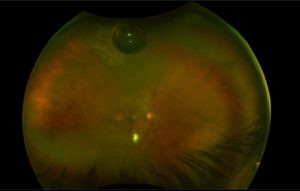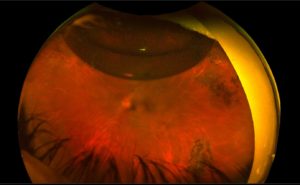During vitrectomy surgery, the vitreous gel in the eye is removed and replaced with a substitute. Depending on the condition, the doctor will determine the best substitute whether it is air, gas or oil in order to allow the retina to heal properly.
Air
Air is the shortest term agent that serves to keep the retinal surface dry until it heals properly. Air bubble can remain in the eye for about 2-10 days depending on the volume. The patient’s vision will be limited as the air bubble remains in their field of vision. As air gets absorbed by the eye, the eye produces its own fluid which will serve to keep the eye formed and nourished indefinitely. Vitreous gel does not get reproduced/replaced as it is really not needed for eye function following birth.
Gases

Gas is a vitreous substitute that serves to keep the retinal surface dry until it heals properly. Gas bubble can remain in the eye for about 2-8 weeks depending on the type and volume of the gas. The patient’s vision will be limited during this time. As the gas gets absorbed by the eye, the eye produces its own fluid which will serve to keep the eye formed and nourished indefinitely. Vitreous gel does not get reproduced/replaced as it is really not needed for eye function following birth.
There are two types of gases utilized for vitreoretinal surgery: Sulfur hexafluoride (SF6) or Octafluoropropane (C3F8). SF6 gas can remain in the eye for 10-20 days whereas C3F8 gas can remain for up to

8 weeks although more typically 6 weeks. It is important to remember that while there is a gas bubble present in the eye, patients cannot fly or go to high altitudes (>1000ft) due to risk of gas expansion and secondary intraocular pressure rise leading to immediate and severe permanent damage to the optic nerve and hence vision.
Silicone Oil
Whereas air and gas bubbles dissolve and dissipate over time, silicone oil is a long term substitute used that does not go away. It is used in cases (e.g. complex retinal detachment) that the retina needs something longer to protect it while it heals. Because it does not get absorbed by the eye, a second surgery is then required in order to remove it, once it has done its job (i.e. retina has healed), which is typically 2-3 months later. Silicone oil should be removed eventually; otherwise it can lead to secondary complications such as glaucoma. However, rarely the oil is left indefinitely in cases where removing it will lead to loss of the retina/eye. One benefit of having oil (vs gas) is that it allows the patient to be able to fly or go to high altitudes (>1000ft).
